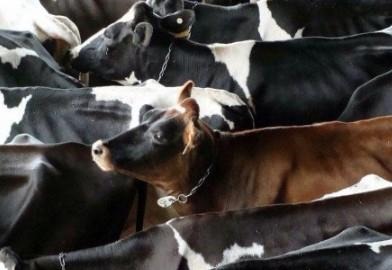By Lisa A. Holden
As spring heads into summer and the temperature creeps higher, thoughts turn to family summer vacations. When we think about that “time away” from home, farm, or work it is with a smile and a happy thought. Our dairy cows, on the other hand, aren’t getting the benefits of a relaxing vacation in their “time away,” as this represents the amount of time that they are away from the pen each day, without access to feed and possibly water. This “cow vacation” can be costly in terms of lower milk yields, less lying time, and increased lameness.

The “time away from pen” is defined as the interval between the time when the first cow leaves the pen and when the last cow returns to the pen. Research (Grant, 2011; Charton et al., 2014) has shown that more than 3.5 to 3.7 hours in time away from pen has a negative impact on lying time, and cows produce less milk. These daily “vacations” can add up in other ways too if cows are held standing on surfaces that negatively impact hoof health, feet and leg integrity, and overall stress under hot conditions. So rather than a day at the beach, cows may be spending that “time away” hot, hungry, thirsty, and uncomfortable. Strategies to measure (and if necessary adjust to lessen) time away from pen can result in healthier and more productive animals.
Depending on the group sizes, parlor routines, barn layouts, and worker routines, some groups of cows may have a time away from pen that allows for adequate, eating, resting, and lying, while others may be feeling the pinch in their daily time budgets. Why? Parlor efficiency has been greatly emphasized over the years, but usually in terms of turns per hour, milk harvested per stall per hour, or hours operated per day. While parlor efficiency is a worthy goal, efficiency at the expense of cow productivity and well-being may be economically counterproductive.
Groups should be sized for parlor efficiency and ease of movement, but large groups or excessive holding pen times just to achieve parlor targets are likely to impact time away from pen resulting in lower milk yields. This is especially true in herds that are 3X milking or those milking fresh cows more frequently. Small changes are multiplied 3 times over the cow’s day.
Worker routines can also be a detriment to cow health with excessive time away from pen due to scraping or feeding times that gate cows out of their pens. Remember, it is not just the time the cows are in the holding pen or the time it takes to milk the group, but the time from FIRST cow out to LAST cow into the pen. Many little steps in between can add up over the day.
With 24 hours in a day, cows like to spend their time:
- lying/resting a minimum of 12 hours,
- eating from 3 to 5 hours,
- drinking about 0.5 hours (so make sure those waterers are clean and available!!), and
- interacting socially 2 to 3 hours (be aware of the impacts of comingling cows and heifers and too many pen moves!!),
- leaving 2.5 to 3.5 hours for time away for management activities. Extending these management activities increases time away from pen and forces the cow to constrict her activities in other areas – eating less, lying less.
So how do you know if a pen of cows has a time away from pen that’s too high? Take a walk in their hooves! Measure the time it takes from that first cow leaving until that last cow returns, and walk through the routine to see where the bottlenecks are. Parlor too slow? Gated out of pen for cleaning stalls? Group moved to holding area too soon? Don’t forget to include any other movements (locks ups for tail chalk) into those daily totals. Each dairy and each situation varies, and each and every pen on that dairy has its own situation for time away from pen. Pay special attention to fresh cows, high cows, or pens that are lower in milk than expected for their stage of lactation.
By measuring and monitoring their time away from pen on a typical day, it is possible to make small (or sometimes large) changes in worker, parlor, or feeding routines in order to benefit a pen of cows that may be underperforming. These seemingly small changes in our routines can allow the cows to enjoy their routines for maximum productivity and health.
Making certain that the cow’s time budget isn’t being disrupted is always important, but never more than when cows are overcrowded or heat stressed in hotter temperatures. So before you plan for your “time away” on this summer’s vacation, take an hour or two to evaluate time away from pen to make sure your cows are on “vacation” too.
Source:psu.edu